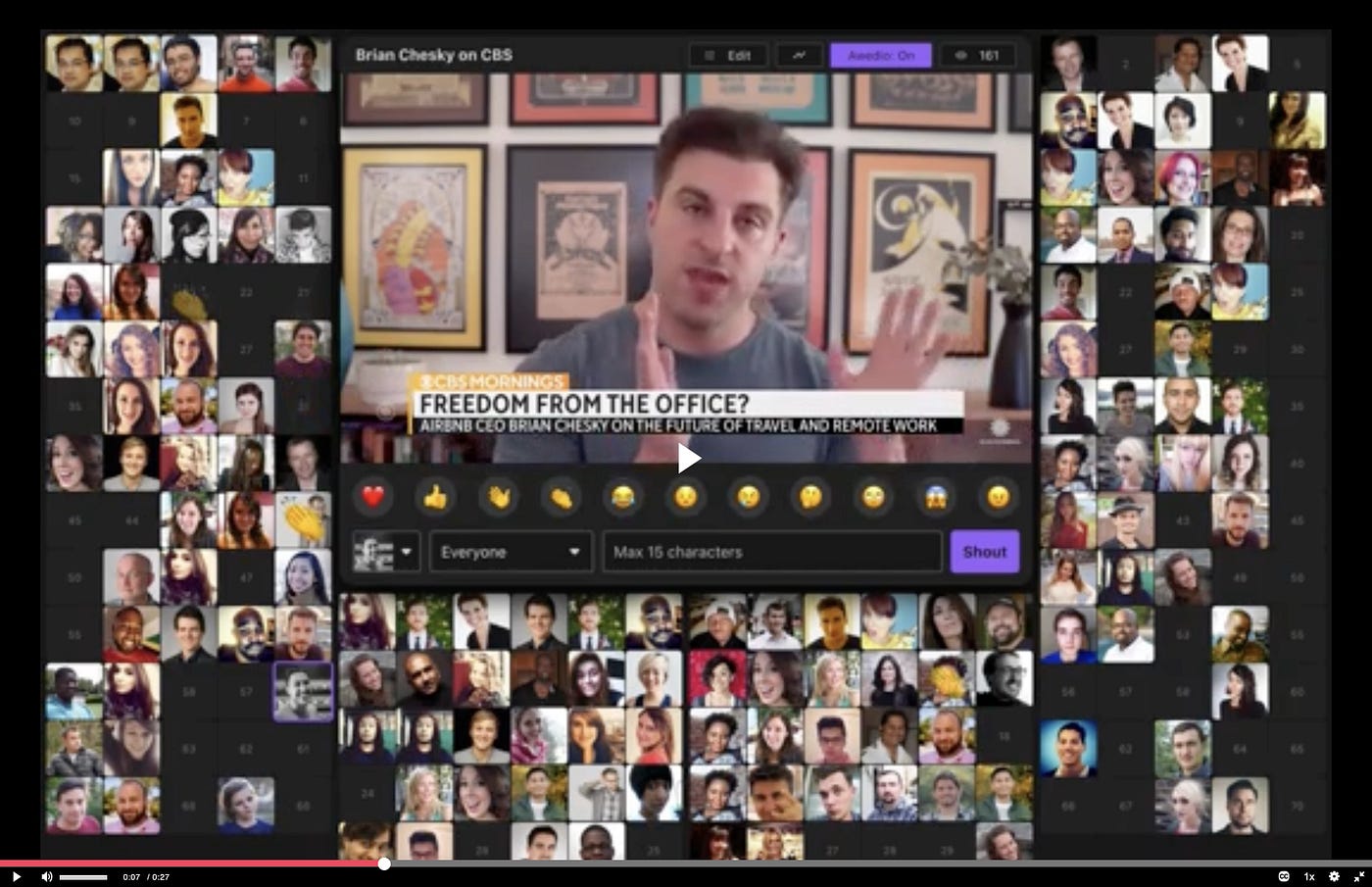

Hacking Human Connection: the Story of Awedience
source link: https://medium.com/airbnb-engineering/hacking-human-connection-the-story-of-awedience-ebf66ee6af0e
Go to the source link to view the article. You can view the picture content, updated content and better typesetting reading experience. If the link is broken, please click the button below to view the snapshot at that time.
Hacking Human Connection: the Story of Awedience
How a home-grown product helps Airbnb employees feel more connected during solitary times
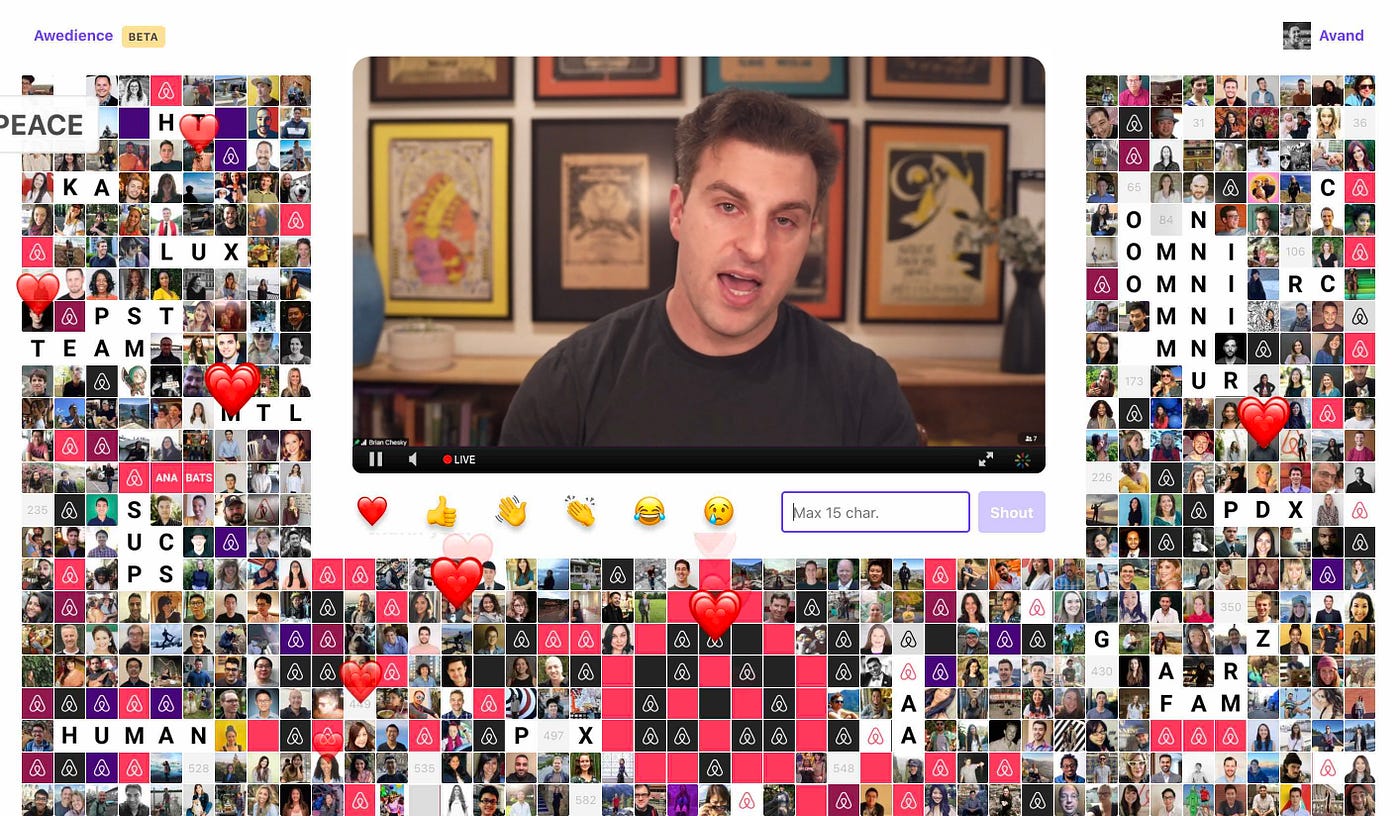
Introduction
This is the story of how Airbnb employees stayed connected during a time they had never felt more apart. In this post, you’ll learn how an idea turned into an internal product that is now a core part of how Airbnb operates.
When you walk through the doors of an Airbnb office, you feel an energy that’s both inspiring and intimidating. After more than five years with the company, I explain this duality as Airbnb being both incredibly entrepreneurial and aspirational.
Airbnb company meetings are no different. Brian Chesky and his team keep our all-hands meetings exciting. I know what you’re thinking: “exciting meetings?!” But in all seriousness our all-hands are not just informative, they’re spectacular. Whether it’s drinking a smoothie of dehydrated bugs in solidarity with Engineering or eating spicy chicken wings in a Hot Ones-style Q&A, our meetings are informative, energizing, and engaging. In somber moments, they’re human and heartfelt.
The pandemic changed that. Feeling connected to the presenter, feeling connected to our peers, or feeling the presenter’s connection to the audience all vanished. Instead, we each separately watched the presenter streaming through a 16:9 rectangle on our laptops. Other people were watching concurrently (one could assume based on the invite) but it couldn’t be felt. Inspired, I set out to solve this, wondering,“we have the technology, why can’t we see and interact with everyone watching live?”
Inspiration
It’s impossible to know under which circumstances inspiration will find us, and in hindsight it seems perfectly planned.
Airbnb is a community based on connection and belonging, which is the reason so many of us came to work here. However, in March of 2020, as the spread of COVID-19 forced us to shelter in place, we struggled to find ways to preserve those traits within our company culture. What it meant to feel connected to the world and to each other was being redefined by emojis over video. Video chat helps us stay in communication, but it’s comically clunky, dry, and lifeless. If these technologies feel contrived it’s because they are. We all know what an authentic human connection actually feels like, and it’s not that.
For almost two years before the pandemic hit, I volunteered to help produce Airbnb’s quarterly engineering all-hands. Unbeknownst to me, I was actually studying the question, “how does one make people feel more connected?” Whether it meant hosting an orca-themed relay race across our Portland, Seattle, and San Francisco offices, or projecting live chat in auditoriums to make the audience more engaged, I had been finding ways to foster human connection.
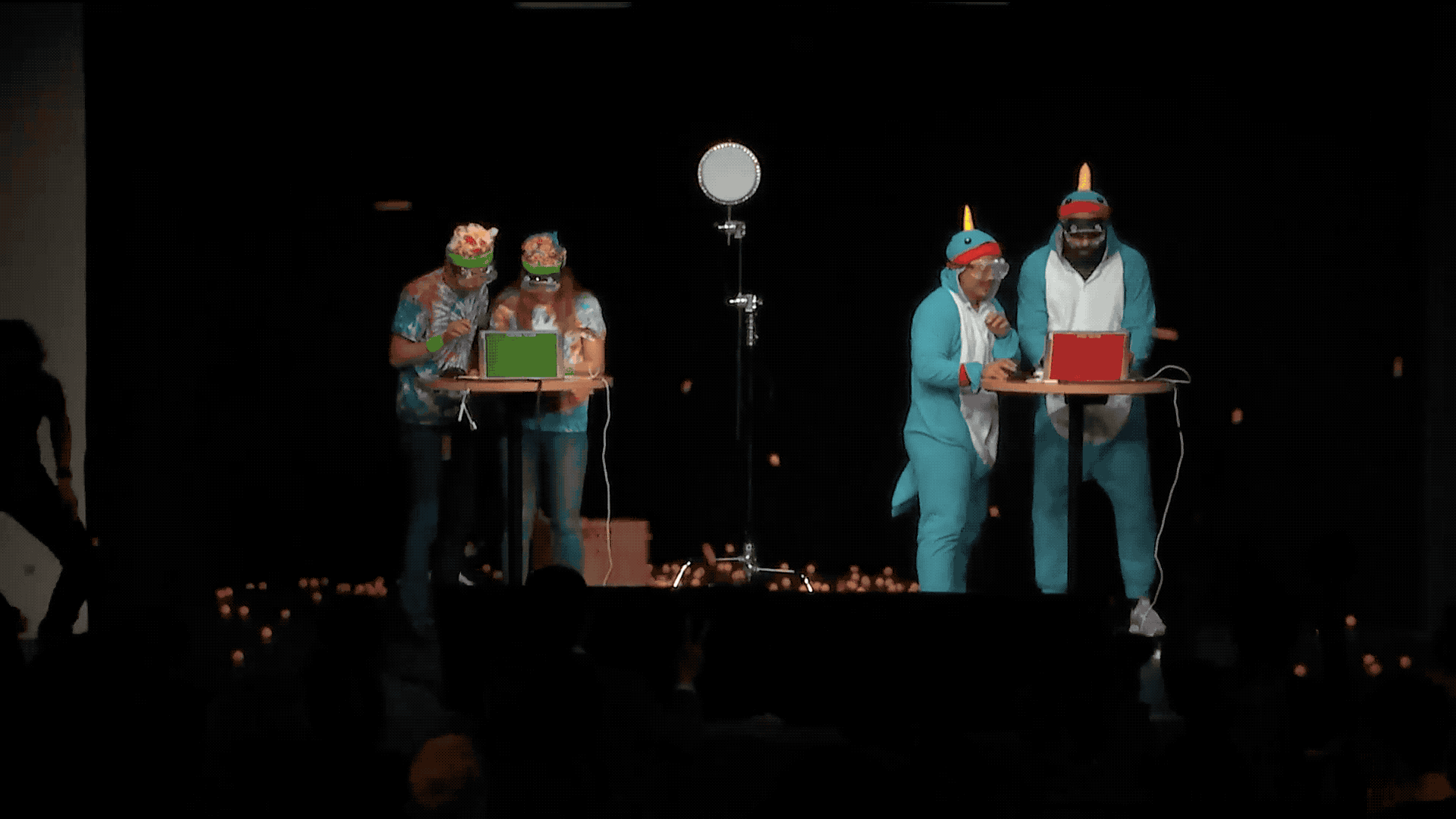
Isolated at home with all these insights into event production, it’s not surprising that, while I watched our CEO, Brian Chesky, address thousands of employees via live stream, my attention drifted to the little number in the top right corner that showed how many other people were watching. These were my colleagues, my friends — some of the most talented people in the world. In our isolation, the only affordance that existed to capture our experience of watching this live stream together was an aggregate count. Instagram and YouTube allowed people to express themselves with emojis and comments during live broadcasts. Internally, we could not.
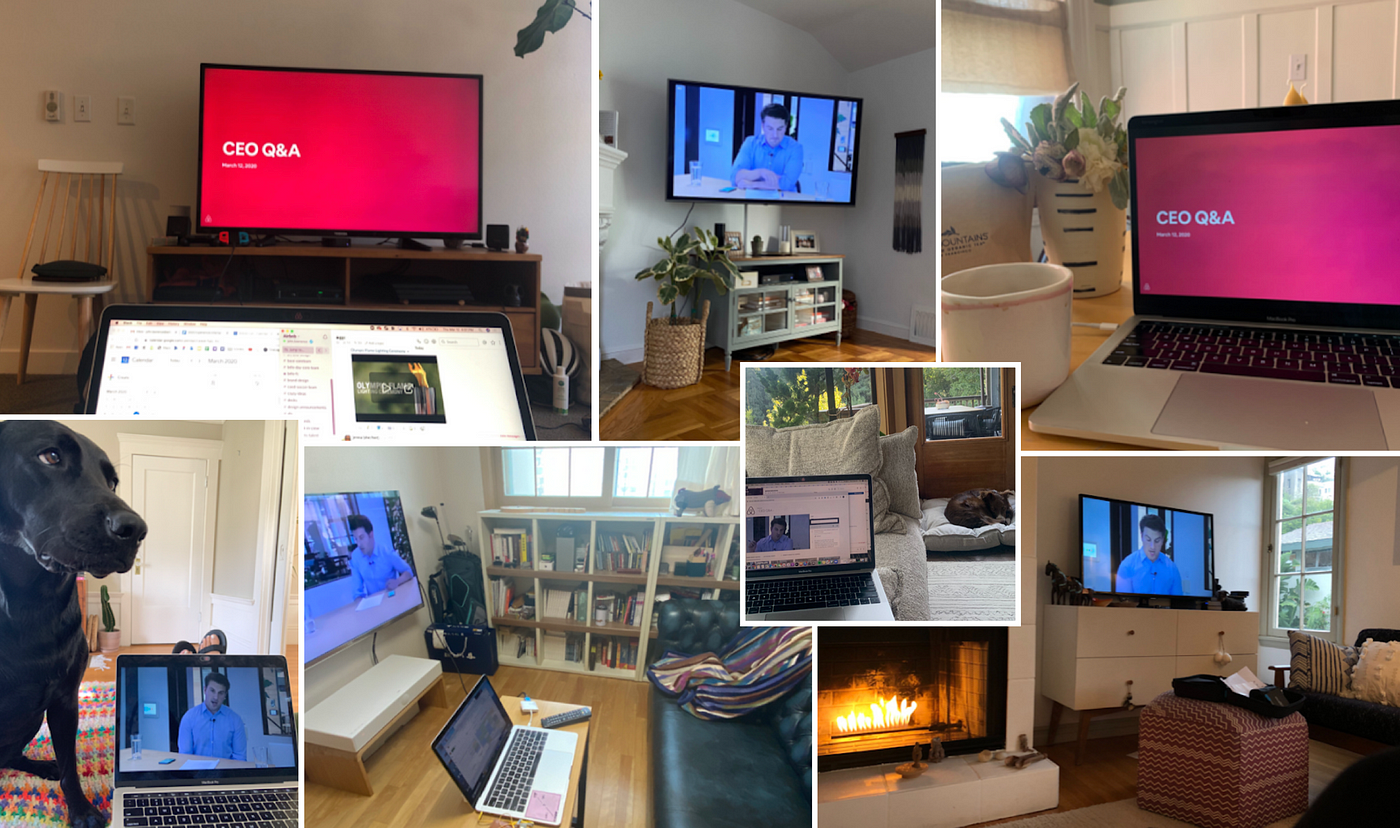
An idea started to emerge: supplement the live stream with small, thumbnail-sized videos of all the viewers’ webcams and capture audience sentiment with emojis. It seemed simple enough.
The original sketch. Simple, right?Yet even this concept proved untenable. I had never built a fully real-time web application and would likely need months to figure out the webcam piece. I didn’t have months. I was only willing to dedicate a few days to see if this idea had merit.
Cereal Entrepreneurs will attest that ideas are cheap — nobody copies ideas. Only proven ideas get copied, and this idea was definitely not proven. So I started to collaborate with some of my peers and Stepan Parunashvili, helped us get the ball rolling. “Punt on video for now,” he said, “start with profile pictures from our company directory. Firebase can handle all the real-time stuff, and we already have an internal authentication service. Boom!”
Stepan continued to offer his support with the initial infrastructure. We needed a name and thought about it for all of a minute. This product was all about the “audience” and “aww” is one sound an audience makes when they’re experiencing something together. Inspiring “awe” was also part of the motivation of this work so we decided on “Awedience.”
Within a few hours, Stepan had the scaffolding complete. People could sign in and “hello world” with other users. Our authentication service played gatekeeper, guaranteeing that the application would have access to an employee’s LDAP username after they signed in. That username enabled me to load a profile picture from our company directory. Firebase served as the realtime database, and React sat right on top of it, bound (almost directly) to Firebase events. I could finally focus on my specialty, UI and UX. With an iframe embedded front and center, the UI naturally formed a U-shaped auditorium with virtual seats. When you clicked a seat, your picture would appear, and as you reacted, emojis would float out of your seat for everyone to see. You could also write short messages and they would pop out of your seat too, simulating shouts to the crowd.
We had built something. Now, would anyone care?
Growth
Attention is an incredibly valuable resource and there are lots of ways to get it. Attention is commonly bought. Attention can be diverted from other channels. It can even be stolen.
But attention can also be earned. When people love a product, it not only has true staying power but will grow organically. Therefore, one way to see if people love something new is to say nothing and observe.
I invited close colleagues to try Awedience for an all-hands to see what would happen. Intuitively, they took a seat, started reacting, and used it throughout the meeting. The feedback was overwhelmingly positive. Awedience didn’t do much but what it did do, it did well enough.
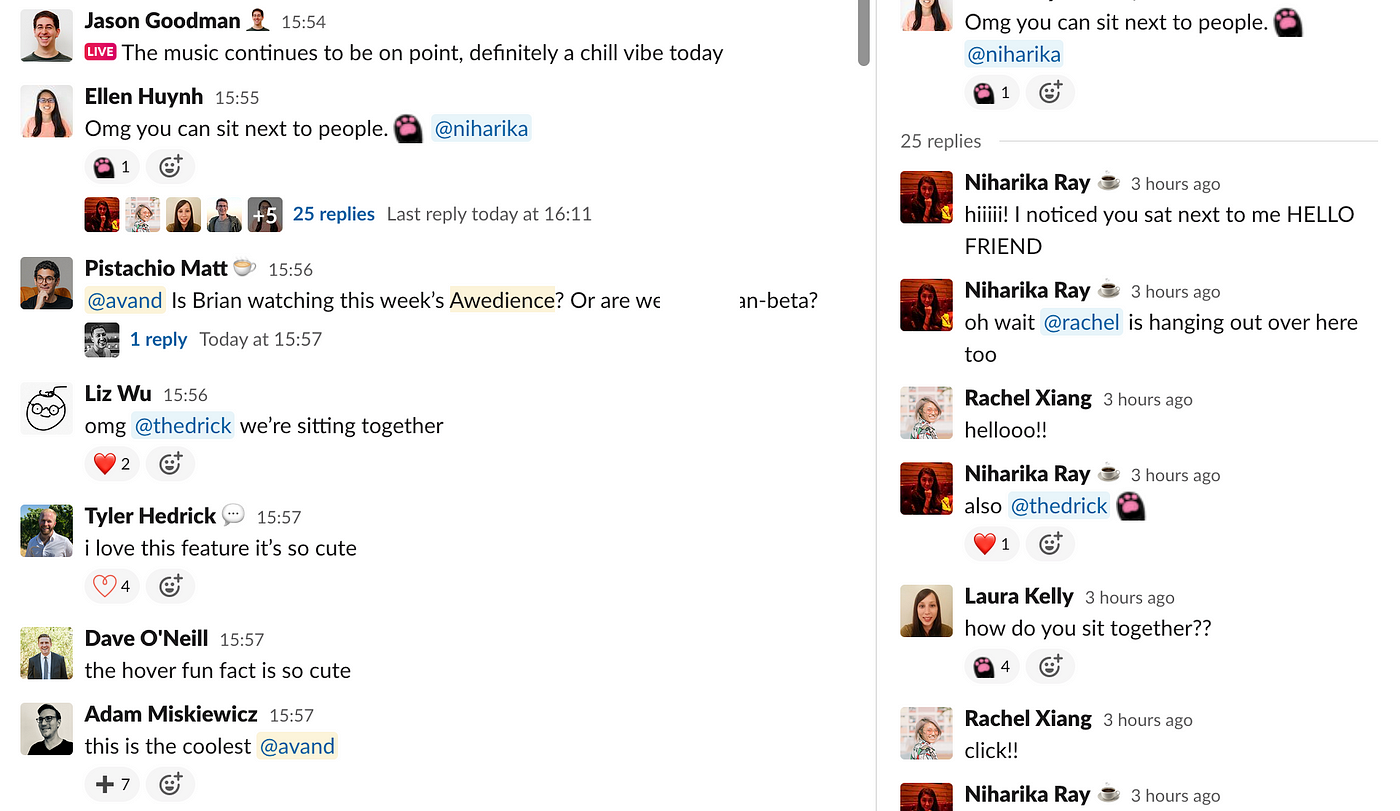
At the time, Brian hosted all-company Q&As weekly. I created a calendar event alongside the all-company one with an alternative URL and only invited people that had previously used Awedience. Within a few months, Awedience was so popular that it was offered as a secondary option in the official calendar invites.
With the increased popularity, it was hard to support Awedience on nights and weekends. I asked my team for time to redirect my focus to Awedience for a few months, and they were supportive. The only request was that I figure out the product’s future by the end of that time and not leave things open-ended. Would it become a part of Online Experiences? Would it become a part of another team’s roadmap? We even speculated that it could be a completely new line of business.
While it was tempting to keep adding functionality, resourcefulness was now the name of the game. Awedience was crashing during peak moments so performance was and still is the most important feature. Before we implemented throttling, we were binding reactions directly to our app state, which triggered a deluge of re-renders:
A crude batchedThrottle function reduced renders when users mashed an emoji button:
Later, additional performance gains were found by detaching the React UI from Firebase real-time callbacks. Eventually, reactions would be managed natively without React at all:
There were more affordances I wanted to explore. At sporting events, attendees often hold up signs, flags, or even paint things on their bodies to spell out a message. Replicating this in Awedience was a huge hit. Rather than a profile picture, attendees could now pick a color, letter, or a portion of a graphic to display from their seat. People show up early and coordinate amongst themselves to spell out messages to represent their team, city, or the company. The result is magical. Awedience didn’t make it easy to tell your neighbor to change their seat picture. People were going out of their way to coordinate with one another. Connection between colleagues was happening organically and it was thrilling to see.
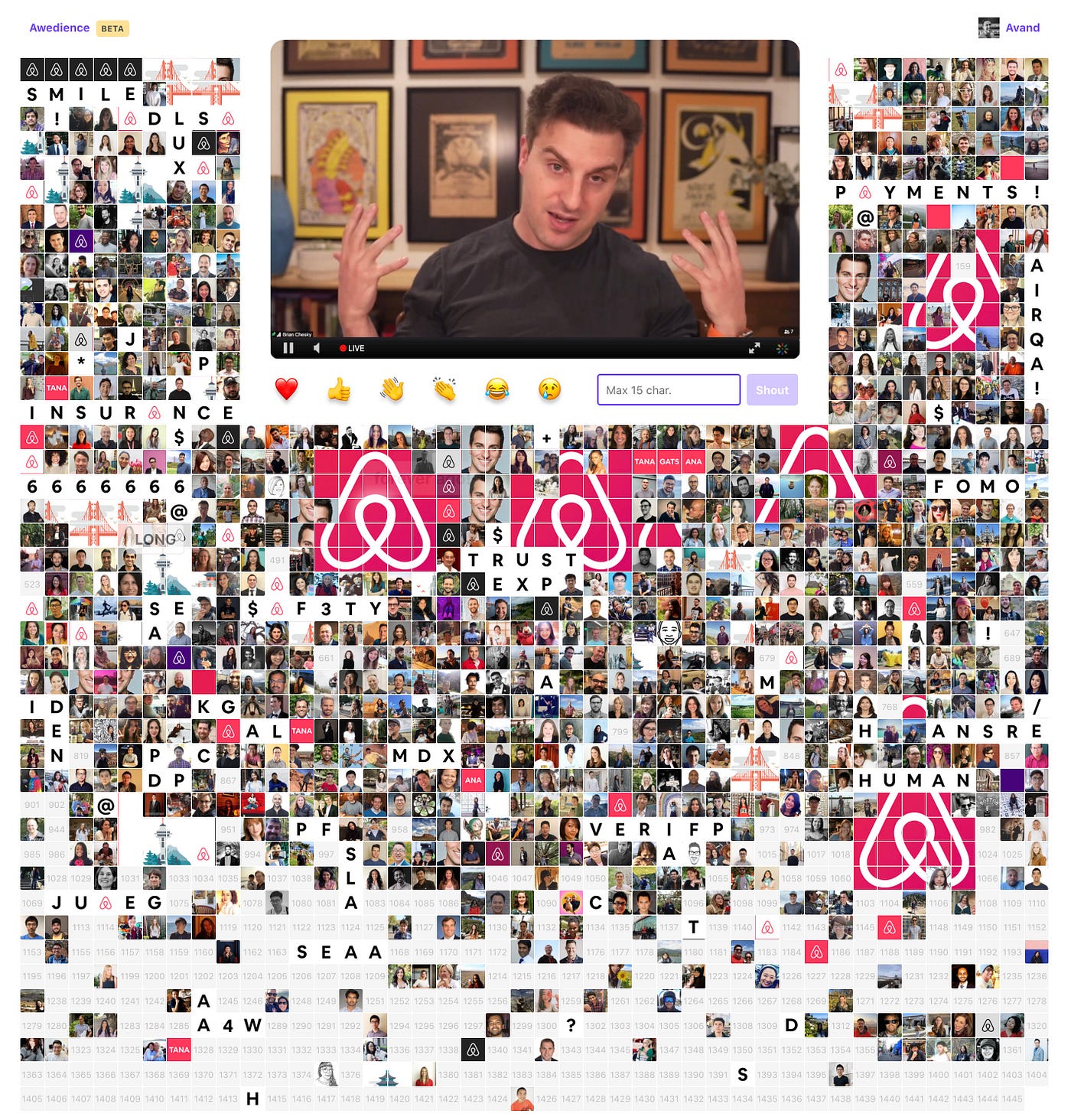
Making sure there were enough seats for everyone was also a challenge. Too few seats and some people can’t participate; too many and the auditorium feels empty. To handle this, Awedience does something its skeuomorphic counterpart can’t do: adding seats as needed. This feature felt vital for a product built at a company so focused on belonging. Later, we would improve on this feature by increasing seating density such that almost 1,000 people are visible “above the fold.”
Adding rows of seats to the bottom worked for a long time but limited users from seeing everyone at once. It took the addition of virtual aisles to afford seats being added horizontally without compromising user-generated seat art.Self-service features were also prioritized. Brian’s staff immediately wanted to know what content was spurring engagement — a question they hadn’t been able to answer since going remote. Cumulative data from each event was piped into a graphing library for quick and dirty analytics. Similarly, our video production team wanted to be able to create and edit auditoriums without relying on me so that self-service tooling came as well.

Later, during a hackathon, we even created applause sound effects that naturally scale up from the sound of a few hands clapping to an uproar based on audience engagement.
Awedio allows you to hear the audience’s applause reactions.Moments
Awedience made Airbnb feel like Airbnb again. There’s now a place where you can see everyone and feel connected to them. It’s become home to celebratory moments and a place where we can sit alongside one another during somber ones.
When Airbnb announced a cut back to our workforce, there was an all-hands scheduled to honor and appreciate the employees who were leaving. However, with VPN access cut to roughly 2,000 soon-to-be alumni, Awedience was suddenly only accessible to the spared employees. Resident security guru, Sam Keeley, and I committed to making Awedience accessible outside of VPN and almost overnight switched authentication to Google IAP. When the founders addressed the company, they invited a standing ovation for our departing peers and Awedience obliged. It’s hard to imagine what kind of impersonal and solitary send-off we would have had without Awedience.
Hundreds of employees joined our founders in a virtual standing ovation for the members of our team that were let go as a result of the pandemic cut backs.In May, in the wake of social action around George Floyd’s murder, the company met to address the Black Lives Matter movement. At the end of this meeting, Brian invited the company to take an 8 minute and 46 second moment of silence.
Employees join in a somber yet moving virtual moment of silence for George Floyd.Conclusion
At Airbnb, Awedience is here to stay and now receives ongoing support and maintenance. In collaboration with our Employee Experience team, we found a home where it would make sense long term. In fact, if this is the kind of work you find interesting, you may even consider joining our team to help us build internal tools to foster connection — we’re hiring!
I feel fortunate to work for a company that creates space to bring these types of projects to life. Airbnb is an inspiring place — the combination and culmination of a rigorous entrepreneurial spirit and an ongoing commitment to outdo the status quo. That’s the type of environment you need for ideas like Awedience to flourish.
Awedience is more than just a triumph of passion and creativity. The spark of the idea was just that: a spark. In the words of Richard Branson, “opportunities are like the buses — there’s always one coming.” Without the help and support of many amazingly talented colleagues, there would literally be nothing to write about.
What makes Awedience awesome is the people. Big ideas are rarely the consequence of one person’s ideas or effort. It takes a lot of people to do incredible things.
Acknowledgements
To Stepan Parunashvili for fueling the fire and bootstrapping the infrastructure that got Awedience going. Without you, it would not have been possible. Thank you.
To Sam Keeley for enabling and evolving Awedience access for the entire company.
To Joe Gebbia for creating some air space for Awedience to grow and evolve.
To Byoung Bae, Allison Frelinger, Darrick Brown, and Judd Antin of my former team for taking a gamble on Awedience with me.
To Liz Kleinman and Beth Axelrod for creating a role for me to continue this work.
To Shawdi Ilbagian Hahn, Dave O’Neill, Kylie McQuain, Kelly Bechtel, Kate Walsh, Benny Etienne, Carrie Kissell, Alyce Thompson, John Lawrence, and Samantha Eaton for your collaboration and partnership in keeping the company engaged and connected.
To Cory Boldt, Steven McNellie, Garrett McGrath, Alex Lacayo, John Espey, and Scott Ethersmith for your help and creativity on the technical productions.
To Jenna Cushner, Ortal Yahdav, Lucille Hua, Christian Williams, Shawn Terasaki, Brian Wallerstein, Ben Muschol, Mike Fowler, Jason Goodman, Caty Kobe, Joe Lencioni, Nicolas Haunold, Christian Baker, Alan Sun, and Jacqui Watts for your early contributions and feedback.
To Kevin Swint, Danielle Zloto, Christine Berry, Federica Petruccio, and Consuelo Hernandez for going above and beyond to try Awedience with Online Experiences and the powerful insights that were created as a result.
To Nicholas Roth, Izzy Rattner, Jonathan Lieberman, Stephen Gikow, Steve Flanders, Lonya Breitel, Alan Shum, Brian Savage, Veronica Mariano, Allie Hastings, Alica Del Valle, Rajiv Patel, and Emily Bullis for your legal support in protecting Awedience’s intellectual property and making external partnerships possible.
To Sarah Baker for always rallying people together to create seat artwork.
To Gaurav Mathur, Hope Eckert, Sean Abraham, Jessie Li, Vaithiyanathan Sundaram, Andy Yasutake, Virginia Vickery, Jonathan Rahmani, Andrew Pariser, Sunakshi Kapoor, Diane Ko, Biki Berry, Francisco Diaz, Erik Ritter, Tony Gamboa, Mohsen Azimi, Bruce Paul, Omari Dixon, Sonia Anderson, CJ Cipriano, Chihwei Yeh, Arie Van Antwerp, Victor De Souza, Sam Shadwell, Deanna Bjorkquist, Jenna Cushner, Richard Kirk, Jake Silver, Alex Rosenblatt, David He, LA Logan, Ryan Booth, Pistachio Matt, Melanie Cebula, Brian Morearty, and Victor Caruso for your participation and support!
To Stephanie Wei, Micah Roumasset, Ryland Harris, Waylon Janowiak, and Ben Arnon for your willingness to try Awedience outside of Airbnb.
To Jerry Chabolla, Nicholas Schell, Ryan Jespersen, Sergio Garcia Murillo, Wes Dagget, and the entire team at Millicast for enabling real-time streaming.
To Brett Bukowski, Cara Moyer, Nicki Williams, Dylan Hurd, and Lauren Mackevich for encouragement and support in writing this blog post.
And lastly to Danee Chavez for powering the light bulb. 💡
Interested in working at Airbnb? Check out these open roles:
Senior Software Engineer, Airfam Products
Staff Technical Program Manager, Insurance Platform
Staff Automation Engineer, BizTech Global Ops
All product names, logos, and brands are property of their respective owners. All company, product and service names used in this website are for identification purposes only. Use of these names, logos, and brands does not imply endorsement.
Recommend
About Joyk
Aggregate valuable and interesting links.
Joyk means Joy of geeK
